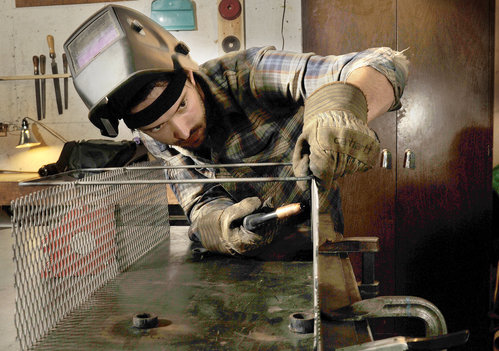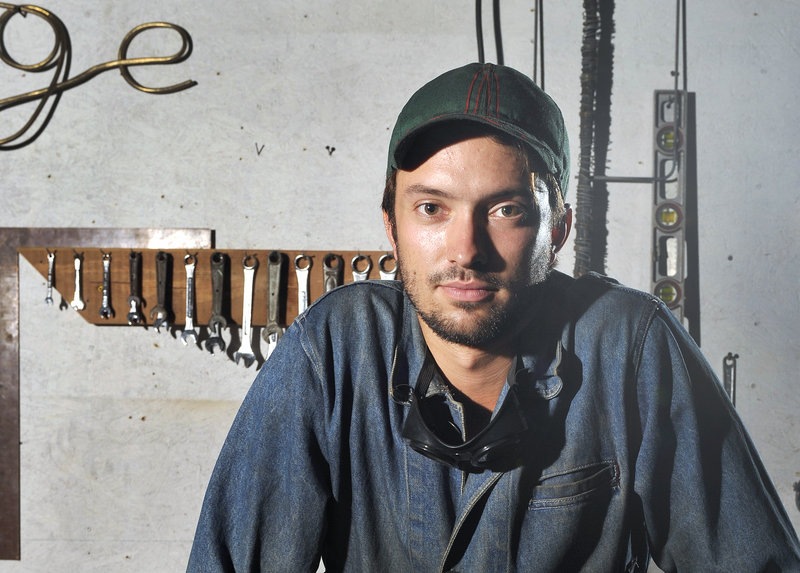PORTLAND — John Nelson makes art out of metal — art that’s both sculptural and functional. His recently commissioned pieces include custom tables and racks for the new Elsmere BBQ and Wood Grill in South Portland, baskets for Broadturn Farm in Scarborough and wall posts for an art gallery on Congress Street.
Making that art produces a greasy, dirty mess, and at times, a lot of noise.
For young artists like Nelson, 25, it’s hard to find affordable places to work in Portland, especially on the peninsula. It once was a haven for young artists, but they are increasingly being forced out by rising property values.
Nelson works in a warehouse on Presumpscot Street — off the peninsula — a space he learned about when he was a student at the Maine College of Art. Asked if he would rather work and show his art closer to his apartment in the West End, he said, “Definitely. That would be really cool.”
That’s why Creative Portland Corp., a nonprofit that supports the city’s creative economy, is undertaking a $60,000 effort over the next year to compile an inventory of art studios and raw industrial spaces that could easily be converted into work and display spaces for artists.
STARTING THE SEARCH FOR SPACE
Creative Portland Executive Director Jennifer Hutchins said artists are feeling the pressure of gentrification as aging parts of the city are converted into more affluent neighborhoods.
Artists were the first to set up shop in the rough-and-tumble Old Port in the 1970s. As commercial interest in the area increased, they were pushed to Congress Street, Hutchins said.
Now, as more young artists look to come here, there appear to be fewer opportunities for them to find affordable working space.
“There isn’t a lot of cheap buildable space in Portland,” Hutchins said. “Figuring out this conundrum of finding a space that works for property owners at a rate that artists can afford is a challenge.”
Earlier this month, Creative Portland received a $30,000 grant from the Portland Downtown Committee to build an online resource guide for artists who want to move to Portland.
To lead the effort, Hutchins said, Creative Portland is forming another nonprofit group, Creative Space, to use the grant to begin compiling an inventory of spaces that could be converted into studios where artists can work and display their art.
Hutchins said the new nonprofit will oversee the effort, which will involve sensitive real estate negotiations that could be considered public information under the umbrella of Creative Portland, a quasi-municipal organization.
“It requires a nimbleness and independence,” Hutchins said.
The city grant requires a $30,000 private match, about half of which has already been raised, said Tom Blackburn, executive director of Creative Space.
According to its grant application, the “Artist and Creative Relocation Guide” will:
• Consist of an inventory of existing and potential creative spaces.
• Identify code and land-use barriers for using existing creative space.
• Create a Web-based clearinghouse of available properties.
• Develop and implement a plan for matching artists with available space, offering advice for repurposing space and moving to new space.
The online clearinghouse would be updated regularly, Blackburn said, with the goal of making it easier for artists to come to Portland.
“We find that artists are incredibly capable in some areas,” Blackburn said, “but there are other areas that are more challenging for them.”
He said he expects to find some raw studio space in Bayside.
CREATING ART IN TIGHT QUARTERS
Nelson’s studio is a 750-square-foot space that is walled off from others by 14-foot-tall plywood walls, which open up to the high ceilings of the warehouse. He pays 80 cents a square foot in monthly rent.
Two old pairs of working gloves with holes in the fingers are nailed above the doorway. Makeshift work benches, vices, drill presses, tools, grinders and torches line the walls, and clamp lights provide much of the lighting.
On a recent afternoon, Nelson set a band saw in motion on a 6-inch-by-3½-inch iron I-beam, which would take about 20 minutes to cut through. During that time, he alternated between two torches to make iron baskets for Broadturn Farm.
As he lit the acetylene torch, a black puff of smoke wafted into the air. Sparks flew as he welded, and bits of metal scattered when he ground the rough edges. His hands and clothes were black with soot.
In the warehouse, William Sears manages Basecamp Studios. His nine studios, ranging from 100 square feet to 200 square feet, rent for $200 and $350 a month, including utilities and Internet.
It’s mostly work space, but it’s occasionally opened up to the public so artists can display their work
“It’s a source of frustration for artists to not find space in (downtown) Portland,” Sears said.
BREAKING DOWN THE SPACE BARRIERS
Creative Portland Corp. was formed in 2008 to help bolster the creative economy, which comprises artists and other professionals such as architects and technology companies.
Creative Portland recently released the results of a survey of 300 artists, conducted to assess the need for work, studio and living space. The survey, completed in June, showed that younger, less affluent artists are more inclined to come to Portland.
Seventy percent of those surveyed said there is a need for work space and that they would be willing to consider partial ownership of a condo or a cooperative. Eighty percent of artists younger than 35 and those earning less than $30,000 a year said the space must be affordable.
In 2011, Creative Portland teamed with Artspace, a national nonprofit that runs a network of 33 affordable arts facilities in 13 states, to look at opportunities for live-work space in Portland.
Artspace identified Portland’s public works fleet facility, in a former general store in Bayside, and the potential development of properties owned by S. Donald Sussman, majority owner of the Portland Press Herald, in the Hampshire Street area as the best options.
Most of the surveyed artists indicated they would rather work outside their homes, and they preferred spaces larger than 100 square feet with natural light and high ceilings.
Work space can be very difficult for certain artists to find, especially those who use welding torches and oil paints, said City Councilor David Marshall, who owns the Constellation Gallery and is executive director of the Maine Artists Collective, a nonprofit group on Congress Street. The need for high ceilings and good ventilation often makes it difficult for artists to find space downtown, he said.
Creative Portland and the fledgling Creative Space hope to find spaces and help break down any barriers to using them.
For Blackburn and Hutchins, a lot is riding on the effort.
“Portland has a clear history of artists paving the way for the success of a given neighborhood,” Hutchins said. “If we fail to acknowledge that and do what we can to carve out pieces of Portland for that particular type of activity, we may displace that altogether and this city begins to take on a whole different flavor.”
Randy Billings can be contacted at 791-6346 or rbillings@pressherald.com
Twitter: @randybillings
Send questions/comments to the editors.




